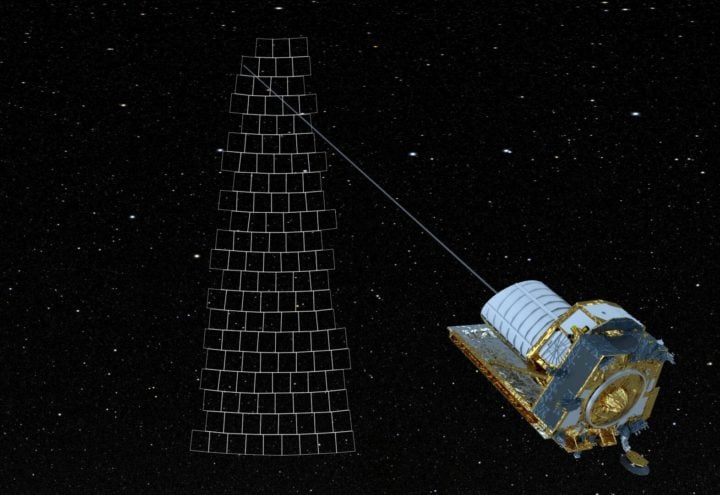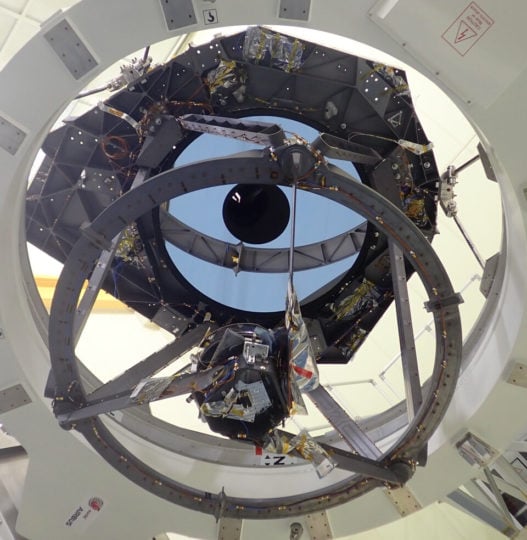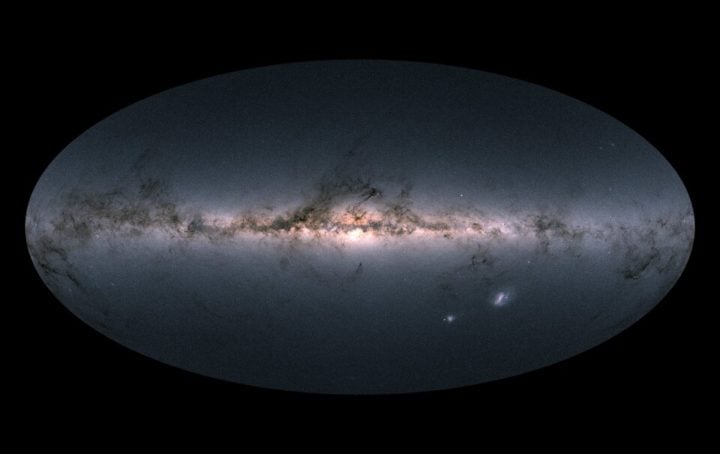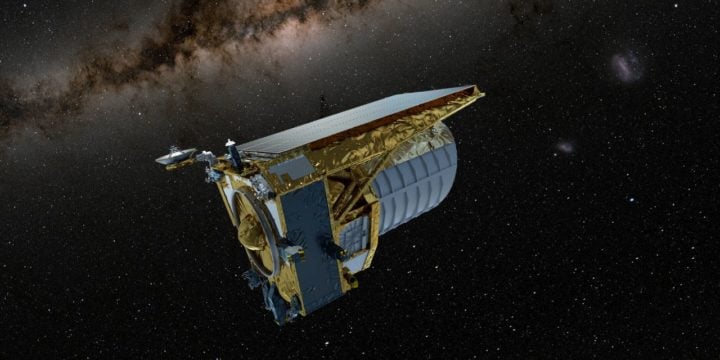Euclid commissioning – the period after launch when a mission’s instruments and subsystems are deployed, turned on, tested and calibrated – began well.
Teams at ESA’s mission control worked 24 hours a day in 12-hour shifts through intense weeks of manoeuvres, tests and calibrations; flying the mission out to Lagrange point 2, its telescope mirrors were de-iced, its NISP and VIS instruments were woken up and saw ‘first light’ and its telescope mirror was focussed. Euclid’s first test images were mesmerising.

Euclid scans across the night sky using a ‘step-and-stare’ method, combining separate measurements to form the largest cosmological survey ever conducted in the visible and near-infrared. Image credit:
ESA. Acknowledgement: Work performed by ATG under contract for ESA., CC BY-SA 3.0 IGO
However, it is rare, if ever, that all goes perfectly throughout the life of a space mission. After all, we can only perform tests on Earth – space is a different world. To operate a spacecraft, engineering and science teams will always need to detect and quickly resolve issues as they arise, and there are a multitude of ways a mission can go wrong.
It’s why months are spent in arduous simulations before launch – you never know quite what will happen.
Now it’s not an outlook we recommend for daily life, but it’s the nature of spacecraft operations to laser focus on the negative. For now, goodbye to Euclid’s better-than-expected optical quality and seamless trip to ‘L2’, time to investigate what’s not quite right.
Lost guide stars likely found

Eye of Euclid. Image credit: Airbus
Euclid is one of the most precise missions ever to be launched, providing razor-sharp images and deep spectra of our Universe, looking back 10 billion years. It will produce a grand survey of one-third of the entire sky. Every 75 minutes for its mission duration of six years, the telescope must point at a new field on the sky with extreme accuracy and stability.
To do this, the spacecraft has a Fine Guidance Sensor (FGS); a completely new development in Europe made of optical sensors that pick out and lock onto stars found by ESA’s Gaia mission, using them as guides to navigate and determine exactly where the telescope needs to point in the sky.
This information is fed into the ‘Attitude and Orbit Control System’ which controls Euclid’s orientation and orbital motion.
While most systems are performing well, there have been intermittent cases of the Fine Guidance Sensor failing to lock onto faint stars. In orbit, Euclid detects the true sky under real space conditions, something which is very hard to simulate before launch. Plus, cosmic rays from the Sun and the galaxy pollute observations, make the job of the FGS a real challenge.

Gaia’s sky in colour. Image credit: ESA/Gaia/DPAC, CC BY-SA 3.0 IGO
Euclid’s commissioning phase was extended in order to look into the issue, delaying the all-important ‘performance verification’. Teams have since been working on a software fix that has now been uploaded onto the spacecraft and is undergoing thorough testing.
“The issue of Euclid’s fine guidance is something we’ve all been concerned about. Teams at ESA’s technical heart (ESTEC), mission control (ESOC), Astronomy Centre (ESAC) and industry have been working day and night, tirelessly for months, and I can’t thank them enough for their determination to resolve the issue,” says Euclid Operations Director Andreas Rudolph.

Euclid is one of the most precise missions ever to be launched, providing razor-sharp images and deep spectra of our Universe, looking back 10 billion years. Image credit: ESA/Euclid/Euclid Consortium/NASA. Background galaxies: NASA, ESA, and S. Beckwith (STScI) and the HUDF Team, CC BY-SA 3.0 IGO
“I’m relieved to say that initial tests are looking good. We’re finding many more stars in all our tests, and while it’s too early to celebrate and more observations are needed, the signs are very encouraging.”
The updated software has already passed with flying colours on a spacecraft simulator and ‘test bench’ (Euclid replica) at mission control, then performed perfectly in orbit and will next be tested under the control of the Science Operations Centre at ESA’s ESAC Astronomy Centre in Spain.
“Obviously, this is where we will have the real test of truth, as only the science images can provide us with absolute certainty that Euclid’s pointing is performing well,” cautions Euclid Project Manager, Giuseppe Racca.
“However, all evidence so far makes us very optimistic. We will continue to keep our fingers tightly crossed, but the restart of the performance verification phase gets nearer every day.”
Dark detective sees unwanted ‘stray light’

Stray light detected in Euclid’s VIS instrument in a small proportion of images. As the angle is altered, the view gets darker as stray light is reduced. Image credit: ESA
While Euclid’s faint, guide stars appear to be found, its next, (smaller) issues come from our nearest star.
Euclid is located at Lagrange point 2 in a unique orbit ‘behind’ Earth. Here, Euclid has its ‘back’ to the Sun, so all the sensitive parts of its telescope are protected from sunlight by a dedicated sunshield. However, it was known that a thruster bracket lay outside the shadow of the sunshield and would receive direct sunlight.
It seems a small amount of sunlight is reflecting off the bracket towards the VISible (VIS) instrument that is protected by many layers of insulation. However, because of the extreme sensitivity of the VIS instrument, the current theory is that enough light is still getting through this insulation, with stray light being detected in test observations when VIS is turned at specific angles.
The majority of VIS’s observations showed no significant stray light interference, but at particular angles, about 10% of observations were affected. Science, engineering and industrial teams spent weeks deciphering which angles let too much of this unwanted light in and have re-designed and optimised Euclid’s survey to constrain each pointing’s orientation in the sky.
While this will not affect Euclid’s ability to take the precise images required, it could impact the efficiency of the survey – something that is still under investigation.
Vis-à-vis the Sun
Sunlight isn’t the only solar issue Euclid faces. If this were an Agatha Christie novel, we’d start to wonder what the Sun is trying to hide from our cosmic detective. Enter: solar flares – sudden eruptions of electromagnetic radiation from the Sun’s surface, made up of light across the entire spectrum, including X-rays.

This image shows what Euclid looks like on the inside, its optical bench. From this angle, light (white arrow) enters the telescope from below and is redirected by several mirrors to a special component called a dichroic. This component separates the visible light (orange arrow) from the near-infrared light (red arrow). Visible light is reflected and directed to the VISible Instrument (VIS, near the top), and near-infrared light passes through it to the Near-Infrared Spectrometer and Photometer (NISP, on the right). Image credit:
Airbus Defense and Space/ESA
Euclid’s detectors are being shielded from low-energy protons that could do them damage. However, it appears that at particular angles, X-rays emitted by the Sun during solar flares can occasionally reach the detectors, spoiling a portion of the images taken at that moment.
Solar activity is currently high as the Sun gets close to the most active period in the current solar cycle, expected to peak in 2024-25.
Analysis currently predicts that, depending on solar activity, Euclid could lose about 3% of its data if this problem were left untackled. However, now that the issue has been discovered teams are able to identify affected pixels and discount them in later analysis and are working on plans to repeat observations to eventually make up for any gaps in Euclid’s cosmological survey.
Optimism for science results to come
It’s important to put the problems above in context. This commissioning period is the time when teams focus hard on uncovering any possible issue that could affect the mission – large or small.

Artist impression of the Euclid mission in space.
Euclid is designed to look far and wide to answer some of the most fundamental questions about our Universe: What are dark matter and dark energy? What role did they play in formation of the cosmic web? The mission will catalogue billions of distant galaxies by scanning across the sky with its sensitive telescope. Image credit: ESA, CC BY-SA 3.0 IGO
Euclid will take remarkable images of our Universe and help piece together how dark energy and dark matter influence the parts of our world that we can see. Euclid’s fine guidance seems close to being solved without any further impact on the mission.
The Sun’s stray light can be mitigated with clever reprogramming of Euclid’s survey and, while the X-ray issue will have a marginal effect, teams are working hard to minimise this through repeat observations and data processing.
Source: European Space Agency

